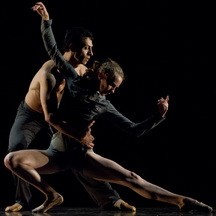A devotion to the spiritual
This past weekend saw the Ronald K. Brown dance company, Evidence, at the Yerba Buena Center for the Arts. Brown’s 25-year-old company is based in Brooklyn, New York, but the dance they perform is based in Brown’s understanding and adaption of African dance forms. Several of his more famous pieces were commissioned by and remain a part of the repertory of the Alvin Ailey Dance Theater. The company performed two of these Ailey pieces, Grace (1999) and Ife/ My Heart (2005).
In many ways, these pieces are identical: both using dance movements derived from walking and running fused into a strong sense of percussive gesture and motion. Both were set to a collage of music and sung and spoken word with strong passages of drumming or rhythmically driven music. And perhaps more importantly, both spoke to a sense of the spiritual.
In Grace, the spiritual is manifest in the form of a female dancer dressed in white, who stands alone on the stage, in a narrow swatch of light, when the curtain opens. Her wild, emphatic dance takes on the tone of a celebration. But it’s a celebration that is laced with sorrow and with fear, as the singer, Jimmy McFail in Duke Ellington’s “Come Sunday,” implores, “Oh God of Love, please look down and see my people through.” Dancers in white and a dazzling clear red wind through each other, repeating patterns, separating and converging. Their bare feet anchor them to the ground. These are earthy dancers of the spirit: the women are voluptuous and the men’s solid bones layered in muscle.
And a sense of family
The dancers follow a similar journey of discovery in Ife/ My Heart, only this time it is as “families” defined by their costumes as well as their interactions. The piece opens again with a single dancer in a shoulder stand in a shaft of light. Three groups follow: the first four dancers are dressed in west African garb translated into satiny white robes; the second group, a man and a woman, wear a white dress and suit suggestive of plantations; the third group is two women and a man, also in white but contemporary and urban in their pleated satin dresses and suit and hat. The music begins with an African prayer and then segues to a poem by Nikki Giovanni. For the most part the three groups don’t interact, but near the end of the piece, the couple dance a pas de deux that is as much a dance to the sun as it is to love.
The most impressive of the evening’s dances was Two-Year Old Gentlemen. Set to the music of Mohammed Camara, which begins with the language of a preacher: “I believe we don’t get weary of the work, but we get weary in the work” and “the blessing is in the quest,” the dance is based on the interaction between Brown’s two-year-old nephew and his grandfather. Five men, dressed in casual variations of suits, one with the pant legs rolled up, meet and dance, their movement and interaction, which is often patterns in staggered repetition, are built on the circle. They trace circles with each other and with their bodies. At times their movements take on those of birds. But what is most enjoyable is the sheer power and energy of these dancers, their commitment to giving everything their strong bodies are capable of.
—Jaime Robles
Originally published in the Piedmont Post.
